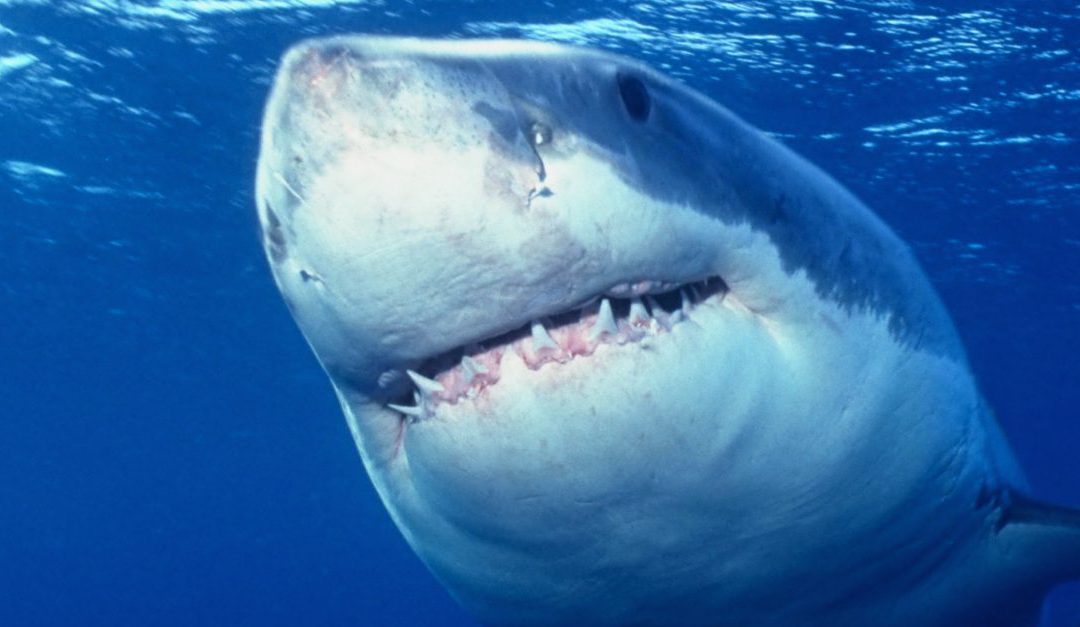
by Laura Tiu | Sep 11, 2020
When one thinks of the Emerald Coast, visions of sparkling water, baby-powder beaches, rental houses and high-rises interwoven with seafood and pizza restaurants appear. The coast is dotted with fishing boats, pirate ships and dolphin cruises and the beaches are littered with people. But it is what glides under the water that some people are curious about. “Are there sharks in the water here?” is a question I often get from locals and tourists alike. The answer is yes, sharks call saltwater home.
Sharks evoke a variety of emotions in people. Some folks are fascinated and list shark fishing and diving with a shark on their bucket lists. Others are terrified, convinced that sharks only exist to hunt them and bite them while they take a swim. Unfortunately for the sharks, their appearance plays into this later fear, with sharp teeth, unblinking eyes and sleek bodies. The reality is that most sharks only grow up to three feet in length and eat small shrimp, crabs and shrimp, not humans. But it is true that bull, tiger and great white sharks are all large species that have been known to attack humans.
Of the 540 different species of sharks in the world, there are about twelve that call the Emerald Coast home including Atlantic sharpnose, bonnet head, blacktip, bull, dusky, great white, hammerhead, nurse, mako, sand, spinner, and tiger. They don’t all stick around all year, with some migrating south in the winter, while others migrate north.
Sharks use their seven senses to interpret their environment: smell, sight, sound, pressure, touch, electroreception, and taste. Most shark attacks occur when a human is mistakenly identified as prey. There are some easy measures you can take to reduce the risk.
- Swim with others, this may intimidate sharks and allows someone to go for help if a bite occurs.
- Remove jewelry as it can look like an attractive shiny fish underwater.
- Don’t swim where folks are fishing as bait in the water may attract sharks.
- Pay attention to any schools of baitfish in the area that may be attracting sharks.
- Do not swim at dusk or dawn when visibility may be poor.
- Learn how to identify various shark species
Remember, shark attacks on humans are rare. Reports of stepping on stingrays, jellyfish stings, lightning, dangerous surf conditions and car accidents greatly outnumber the number of shark attacks every year.
For more information: https://www.floridamuseum.ufl.edu/sharks/education-resources/
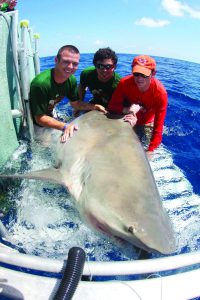
A bull shark being tagged by researchers (credit: Florida Sea Grant).
“An Equal Opportunity Institution”
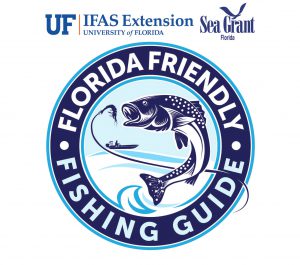
by Laura Tiu | Jul 3, 2020
Fishing is big business in Florida, contributing billions of dollars each year to the state’s economy. Fishing guides are an important part of the fishing industry. Guides provide locals and tourists alike with authentic Florida fishing experiences and memories that last a lifetime. Fishing guides are role models that can teach ethical angling through their onboard behaviors.
The Florida Friendly Fishing Guides Certification was developed by the University of Florida IFAS Extension, Florida Sea Grant, and the Florida Fish and Wildlife Conservation Commission with input from fishing guides. It is a voluntary certification program and involves no regulatory component. The target audience is flats guides, charter boat captains, and head-boat captains and crew. Recreational fishers are welcome to take the course, too.
What will I learn?
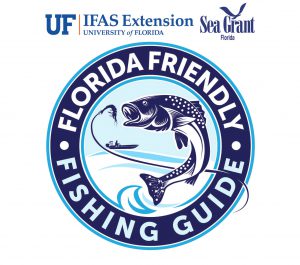 The Florida Sea Grant Florida Friendly Fishing Guide online course teaches best practices for catch and release fishing. Each lesson plan focuses on a different aspect of ethical angling. There are modules on seafood safety, federal and state fisheries management, onboard waste management, and how to teach your customers about the environment.
The Florida Sea Grant Florida Friendly Fishing Guide online course teaches best practices for catch and release fishing. Each lesson plan focuses on a different aspect of ethical angling. There are modules on seafood safety, federal and state fisheries management, onboard waste management, and how to teach your customers about the environment.
One environmental impact of fishing is what we call discard mortality. This is when a caught fish is released but does not survive. You will learn how to increase fish survival, how to identify barotrauma, and how to use descending and venting tools.
Starting July 15, 2020, a descending device will be required for head-boats, charter boats, commercial, and recreational vessels fishing for reef fish in federal waters of the Atlantic Ocean from North Carolina to Florida. The Florida Friendly Fishing Guide course will teach you how to identify barotrauma and select the right tool for sending fish back down to depth! Proper fish handling skills are important because up to 60% of caught fish are released.
The cost is $130 and the course takes about 4 hours to complete. Once you complete the course you receive a welcome package, public listing on the Florida Sea Grant website, and an optional social media promotion. For more information and registration go to https://www.flseagrant.org/florida-friendly-fishing-guide-certification/ or contact your local Florida Sea Grant agent, Laura Tiu, lgtiu@ufl.edu. Florida Friendly Fishing Guide Certification is a state-wide program for all saltwater fishing guides in Florida.
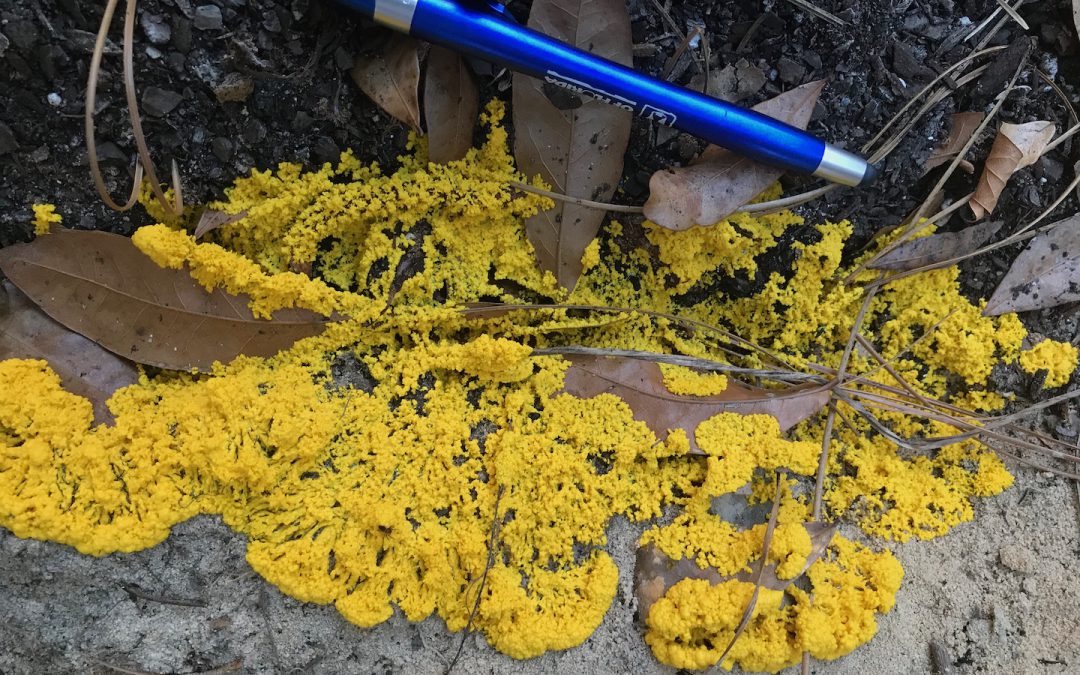
by Laura Tiu | May 22, 2020
Have you ever been on a walk, passed a beautiful flowering bush, and wondered what it was? Well, wonder no more! You can become an expert naturalist by using an easy smartphone app, iNaturalist. With one easy download, you can connect with others to identify species and document their occurrence.
iNaturalist is a community of naturalists, citizen scientists and biologists working together to share observations of biodiversity and map the occurrence. Parents need to know that iNaturalist is an online community that allows users age 13 and older to share pictures and locations of the living things they see around them. While considered very safe, like any online network, teens should be cautious with sharing.
Getting started is easy. All you need to do is create an account at iNaturalist.org and download their free iNaturalist app to your smartphone (Android or iOS). You can then start making your own nature observations, upload them to iNaturalist where you can share your discoveries with others, and also let other iNaturalist users help identify what you have seen.
iNaturalist is a great way to connect with nature and generate scientifically valuable biodiversity data. You can use it for your own personal fulfillment, or as part of a group. You can even use the project feature which allows you to have a central page that displays all the observations made within a location, or all observations made by a group. Why not organize your neighbors, club, or friends and challenge them to post their observations?
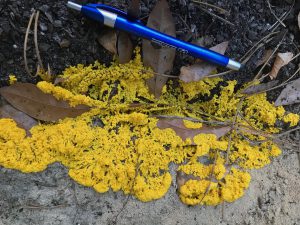
Mystery blob in the garden. Can you figure out what it is? Photo: Laura Tiu
I recently used iNaturalist to identify a bright yellow blob that sprung up in my garden overnight. I won’t spoil the surprise by telling you what it is. Why don’t you head on over to iNaturalist.org and see if you can figure it out? It will be your first step to becoming an expert naturalist.

by Laura Tiu | Jan 10, 2020
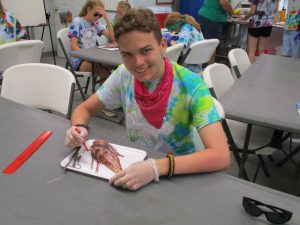
A 4-H youth at Camp Timpoochee Marine Camp dissecting a lionfish.
Are you interested in learning about marine life, going fishing, or exploring the underwater world with a mask and snorkel? If so, this is the camp for you! This local education opportunity for budding marine scientists will be happening this summer at Camp Timpoochee in Niceville, FL. The camps enable participants to explore the marine and aquatic ecosystems of Northwest Florida; especially that of the Choctawhatchee Bay. Campers get to experience Florida’s marine environment through fishing, boating snorkeling, games, STEM (science, technology, engineering & math) activities and other outdoor adventures. University of Florida Sea Grant Marine Agents and State 4-H Staff partner to provide hands-on activities exploring and understanding the coastal environment.
Florida Sea Grant has a long history of supporting environmental education for youth and adults to help them become better stewards of the coastal zone. This is accomplished by providing awareness of how our actions affect the health of our watersheds, oceans and coasts and marine camp is a great opportunity for sharing that information. Many of the Sea Grant youth activities use curriculum developed by the national Sea Grant program and geared toward increasing student competency in math, science, chemistry and biology. The curriculum is fun and interesting!
Registration opens Monday, January 13th at 11:00 am CST. The camps fill up quickly, so early registration is encouraged. Marine Camp is open to 4-H members and non 4-H members between the ages of 8-12 (Junior Camp) and ages 13-17 (Senior Camp). In the summer of 2020, there will be one Senior camp, June 22-26, and two Junior Camps, July 13-17 and July 20-24. The cost for Senior Camp is $350 for the week and $300 for Junior Camp.
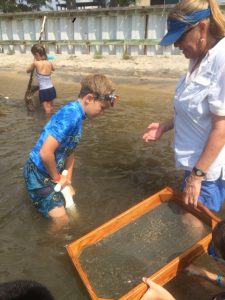
Sampling the benthic community at Timpoochee.
If Marine Camp sounds interesting to someone you know, visit the Camp Timpoochee website at http://florida4h.org/camps_/specialty-camps/marine/ for the 2020
dates and registration instructions. A daily snack from the canteen and a summer camp T-shirt are included in the camp fees, along with three nutritious meals per day prepared on site by our certified food safety staff. All cabins are air-conditioned. So many surprises await at marine camp, come join the fun.
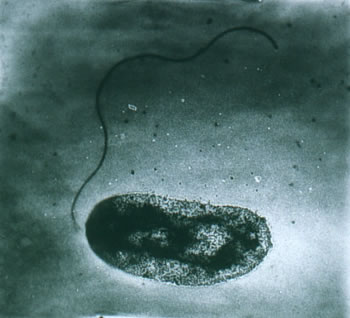
by Laura Tiu | Aug 9, 2019
During a recent fishing trip, as we jigged for bait and got repeated stuck by the tiny hooks, talk turned to the recent reports of a death and infections in the Florida Panhandle from the saltwater-dwelling bacterium, Vibrio vulnificus. Many reports used the term “flesh-eating bacteria” to refer to Vibrio. This description is false and misleading and causes unnecessary fear and panic. Most healthy individuals are not at risk for V. vulnificus infection, however, to ensure that your time on the water is safe and enjoyable, be aware of your risk and take steps to minimize becoming infected.
The name Vibrio refers to a large and diverse group of marine bacteria. Most members are harmless, however, some strains produce harmful toxins and are capable of causing a disease known as “vibriosis.” Because of Florida’s warm climate, Vibrio are present in brackish waters year-round. They are most abundant from April to November when the water is the warmest. For infection to occur, pathogenic Vibrio strains must enter the body of a susceptible individual who either eats raw and contaminated seafood or exposes an open wound for a prolonged period in water containing these bacteria.
Symptoms of vibriosis may arise within 1–3 days, but usually occur a few hours after exposure. Infections typically begin with swelling and redness of skin, followed by severe pain, blistering, and discharge at the site of the wound. If you suspect infection, seek medical treatment immediately.
Anglers can reduce their risk by following a few safety tips. Because fish, including live bait, carry Vibrio on their bodies, avoid or minimize handling whenever possible. The proper use of landing gear and release tools can help to minimize handling. If you cannot avoid handling the fish, use a wet towel or gloves to protect yourself. Be aware of areas that can cause injury like spines, barbs, and teeth.
Always wash your hands thoroughly after fishing, especially before handling food. Be sure to clean your gear after each use, taking special care with sharp objects like hooks and knives.
Adapted from: Abeels, H., G. Barbarite, A. Wright, and P. McCarthy. 2016. Frequently Asked Questions about Vibrio in Florida. SGEF-231. https://eos.ucs.uri.edu/EOS_Linked_Documents/flsgp/SGEF_231_fact-sheet_2016.pdf
“An Equal Opportunity Institution”
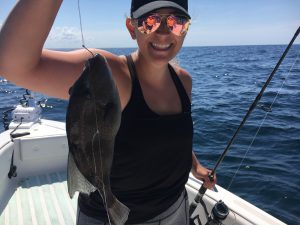
A happy angler with a Trigger fish near Destin, Florida (Photo credit: L. Tiu).











